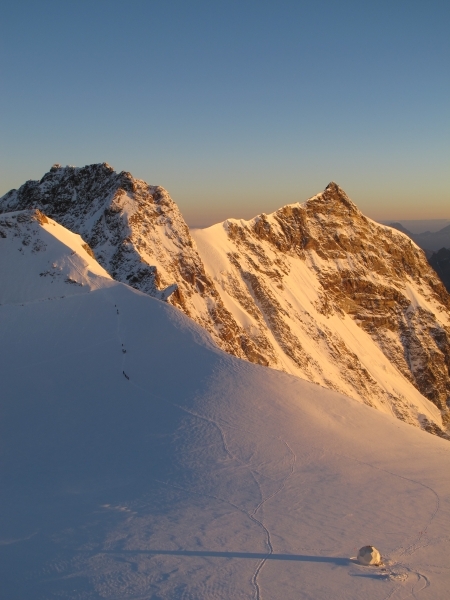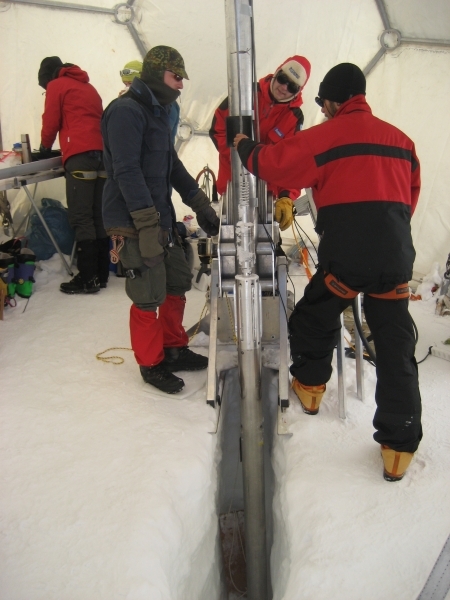
With generous support from:

In 2013, a joint venture of the Climate Change Institute at the University of Maine, and the SoHP retrieved a 73-meter (240ft) ice core from the Colle Gnifetti glacier in the Swiss Alps. Analysis of the ice core, at the Climate Change Institute, is producing invaluable new data about climate change and human-climate interactions from the last ca. 2,000 years. Concurrently, Harvard historians are combing pre-industrial written records to create a new geo-database of climate events, which complements the scientific data.
As documented here, a seven-person team from the Climate Change Institute, the Institut für Umweltphysik, University of Heidelberg (Germany) and the Physics Institute, University of Bern (Switzerland), recovered the ice core over the course of one week at the Colle Gnifetti (CG) glacier saddle of the Monte Rosa Massif (4450 m.a.s.l.). It will be analyzed using a host of technologies not available when previous CG cores were drilled and featuring a path-breaking collaboration of humanists and scientists.


To this end the University of Maine and Harvard University have been producing ultra-high-resolution measurements of dust and other impurities using state-of-the-art laser based technology developed in the Climate Change Institute’s W. M. Keck Laser Ice Facility at the Climate Change Institute and a new historical geodatabase of the climate of pre-modern Europe from written sources, collected and analyzed at Harvard.
The resulting records are allowing the first detailed, ice core-based assessment of human-climate interactions during the last two millennia. The new technology is minimally destructive and will allow the permanent preservation of the new ice core record. The project is supported by a grant from the Arcadia Foundation.
Evaluation of this unique archive involved researchers from Alfred-Wegener-Institute, Bremerhaven (Germany) and the Department of Geosciences, University of Fribourg (Switzerland), and the University of Nottingham, (U.K.).
Photos by Dr. Nicole Spaulding
Dr. Nicole Spaulding describes how laser ablation extracts ancient
ice particles for mass spectrometry of chemical signals of
climate change from the SoHP Colle Gnifetti Historical Ice Core
On Nov. 11, 2015, The CCI-SoHP team presented preliminary results at a signature event at Harvard University.
2015
“New LA-ICP-MS cryocell and calibration technique for sub-millimeter analysis of ice cores.” Journal of Glaciology, 61.226 (2015), 233-42. doi: 10.3189/2015JoG14J139.
S.B. Sneed, P.A. Mayewski, W.G. Sayre, M.J. Handley, A.V. Kurbatov, K.C. Taylor, P. Bohleber, D. Wagenbach, T. Erhardt, N.E. Spaulding.
Ice cores provide a robust reconstruction of past climate. However, development of timescales by annual-layer counting, essential to detailed climate reconstruction and interpretation, on ice cores collected at low-accumulation sites or in regions of compressed ice, is problematic due to closely spaced layers. Ice-core analysis by laser ablation–inductively coupled plasma–mass spectrometry (LA-ICP-MS) provides sub-millimeter-scale sampling resolution (on the order of 100 μm in this study) and the low detection limits (ng L−1) necessary to measure the chemical constituents preserved in ice cores. We present a newly developed cryocell that can hold a 1 m long section of ice core, and an alternative strategy for calibration. Using ice-core samples from central Greenland, we demonstrate the repeatability of multiple ablation passes, highlight the improved sampling resolution, verify the calibration technique and identify annual layers in the chemical profile in a deep section of an ice core where annual layers have not previously been identified using chemistry. In addition, using sections of cores from the Swiss/Italian Alps we illustrate the relationship between Ca, Na and Fe and particle concentration and conductivity, and validate the LA-ICP-MS Ca profile through a direct comparison with continuous flow analysis results.
2017
“Next generation ice core technology reveals true minimum natural levels of lead (Pb) in the atmosphere: insights from the Black Death.” GeoHealth (AGU), 1 (2017): 211-19. doi: 10.1002/2017GH000064.
A.F. More, N.E. Spaulding, P. Bohleber, M.J. Handley, H. Hoffmann, E.V. Korotkikh, A.V. Kurbatov, C.P. Loveluck, S.B. Sneed, M. McCormick, P.A. Mayewski
Current policies to reduce lead pollution in the air are based on the assumption that preindustrial levels of lead in the air were negligible, safe, or nonexistent. This trans‐disciplinary article shows that this is not the case, using next‐generation laser technology in climate science, in combination with detailed historical and archaeological records in as many as seven languages from all over Europe. We show that lead levels in the air have been elevated for the past 2000 years, except for a single 4-year period. This 4-year period corresponds with the largest pandemic ever to ravage Western Europe (the Black Death), resulting in a 40–50% reduction in population and interrupting mining and smelting of lead in the European continent. This unprecedented population collapse and severe economic decline halted lead mining and smelting and related emissions of lead in the air. It uses next‐generation technology and expertise in history, climate science, archaeology, and toxicology, brought to bear in a detailed contribution of ancient evidence to planetary health, with crucial implications now for public health and environmental policy, and the history of human exposure to lead.
“Possible Icelandic tephra found in European Colle Gnifetti Glacier.”
Geochemistry, Geophysics, Geosystems (AGU), 18.11 (2017). doi: 10.1002/2017GC007022.
M.T. Luongo, A.V. Kurbatov, T. Erhardt, P.A. Mayewski, M. McCormick, A.F. More, N.E. Spaulding, S.D. Wheatley, M.G. Yates, P.D. Bohleber
Volcanic ash (tephra) provides unique time markers (isochrons) that are often used as an independent age‐control tool for stratigraphic correlations of paleoclimate archives from ice cores. However, little credence has been given to the notion of finding tephra in ice cores collected in the European Alps because of the relatively large distance from volcanic sources and the presumed nature of regional atmospheric circulation patterns. We filtered particles from melted ice core drilling chips gathered roughly every meter during a 2013 drilling operation at Colle Gnifetti glacier in the Swiss‐Italian Alps (45°55.74′N, 7°52.58′E, 4450 m asl). One filter, preliminarily dated to the nineteenth century by annual layer counting, contained a group of six visually similar tephra particles. Analyzing their chemistry using a scanning electron microscope equipped with an energy‐dispersive x‐ray spectrometer established that the six particles were volcanic in origin and are very similar in composition (a distinctive geochemical signature), pointing to a single volcanic eruption source. We proposed that one of several massive nineteenth century Eastern Icelandic eruptions is a potential source given eruption timing, size, tephra dispersion area, and similarities in chemical composition. This first finding of tephra in an Alpine ice core contributes to a regional tephrochronological framework that can be adapted for future correlation among different paleoclimate sequences. The lead author was a Harvard undergraduates working with the Science of the Past in the Departments of Earth and Planetary Sciences and History.
“A new multielement method for LA-ICP-MS data acquisition from glacier ice cores.” Environmental Science and Technology, 51.22 (2017): 13282–87. doi: 10.1021/acs.est.7b03950.
N.E. Spaulding, S.B. Sneed, M.J. Handley, P.Bohleber, A.V. Kurbatov, N.J. Pearce, T. Erhardt, P.A. Mayewski.
To answer pressing new research questions about the rate and timing of abrupt climate transitions, a robust system for ultrahigh-resolution sampling of glacier ice is needed. Here, we present a multielement method of LA-ICP-MS analysis wherein an array of chemical elements is simultaneously measured from the same ablation area. Although multielement techniques are commonplace for high-concentration materials, prior to the development of this method, all LA-ICP-MS analyses of glacier ice involved a single element per ablation pass or spot. This new method, developed using the LA-ICP-MS system at the W.M. Keck Laser Ice Facility at the University of Maine Climate Change Institute, has already been used to shed light on our flawed understanding of natural levels of Pb in Earth’s atmosphere.
2018
“Temperature and mineral dust variability recorded in two low-accumulation Alpine ice cores over the last millennium.” Climate of the Past, 14 (2018): 21-37. https://doi.org/10.5194/cp-14-21-2018.
P. Bohleber, T. Erhardt, N.E. Spaulding, H. Hoffmann, H. Fischer, P.A. Mayewski.
Among ice core drilling sites in the European Alps, Colle Gnifetti (CG) is the only non-temperate glacier to offer climate records dating back at least 1000 years. This unique long-term archive is the result of an exceptionally low net accumulation driven by wind erosion and rapid annual layer thinning. However, the full exploitation of the CG time series has been hampered by considerable dating uncertainties and the seasonal summer bias in snow preservation. Using a new core drilled in 2013 we extend annual layer counting, for the first time at CG, over the last 1000 years and add additional constraints to the resulting age scale from radiocarbon dating. Based on this improved age scale, and using a multi-core approach with a neighboring ice core, we explore the time series of stable water isotopes and the mineral dust proxies Ca2+ and insoluble particles. Also in our latest ice core we face the already known limitation to the quantitative use of the stable isotope variability based on a high and potentially non-stationary isotope/temperature sensitivity at CG. Decadal trends in Ca2+ reveal substantial agreement with instrumental temperature and are explored here as a potential site-specific supplement to the isotope-based temperature reconstruction. The observed coupling between temperature and Ca2+ trends likely results from snow preservation effects and the advection of dust-rich air masses coinciding with warm temperatures. We find that if calibrated against instrumental data, the Ca2+-based temperature reconstruction is in robust agreement with the latest proxy-based summer temperature reconstruction, including a “Little Ice Age” cold period as well as a medieval climate anomaly. Part of the medieval climate period around CE 1100–1200 clearly stands out through an increased occurrence of dust events, potentially resulting from a relative increase in meridional flow and/or dry conditions over the Mediterranean.
“The role of historical context in understanding past climate, pollution and health data in trans-disciplinary studies.” GeoHealth (AGU), 2 (2018): 162-70. doi:10.1029/2017GH000121.
A.F. More, N.E. Spaulding, P. Bohleber, M.J. Handley, H. Hoffmann, E.V. Korotkikh, A.V. Kurbatov, C.P. Loveluck, S.B. Sneed, M. McCormick, P.A. Mayewski.
This article highlights the crucial importance of historical and archaeoscientific data in trans‐disciplinary studies of planetary health, in the form of a reply to two comments to a previous article (More et al., 2017, https://doi.org/10.1002/2017GH000064). This reply emphasizes the crucial importance of geographic and historical context in assessing the significance and reach of scientific findings. The article also showcases the growing role of “Big‐Data” scale data sets of demographic, epidemiological, and historical records for understanding how past pollution and climate data affected populations, especially when cutting‐edge methods (e.g., laser ablation inductively coupled plasma mass spectrometry) in climate science provide an ever more detailed chronology of past crises and long‐term pollution trends.
“Alpine ice-core evidence for the transformation of the European monetary system, AD 640-670.” Antiquity (2018) https://doi.org/10.15184/aqy.2018.110
C.P. Loveluck, M. McCormick, N.E. Spaulding, H. Clifford, M.J. Handley, L. Hartman, H. Hoffmann, E.V. Korotkikh, A.V. Kurbatov, A.F. More, S.B. Sneed, P.A. Mayewski.
The seventh-century CE switch from gold to silver currencies transformed the socio-economic landscape of Northwest Europe. The source of silver, however, has proven elusive. Recent research, integrating ice-core data from the Colle Gnifetti drill site in the Swiss Alps, geoarchaeological records and numismatic and historical data, has provided new evidence for this transformation. Annual resolution ice-core data are combined with lead pollution analysis to demonstrate that significant new silver mining facilitated the change to silver coinage, and dates the introduction of such coinage to c. CE 660. Archaeological evidence and atmospheric modelling of lead pollution locates the probable source of the silver to mines at Melle, in France.
"SI data on Colle Gnifetti Tephra from AD 536 volcanic event." Antiquity (2018)
L. Hartman & A.V. Kurbatov.
This supplemental information document and dataset, published with Loveluck et al., 2018, discusses tephra (volcanic ash) evidence of the the 536C.E. volcanic eruption in the Colle Gnifetti glacier.
2019
“Climates of history, histories of climate: from history to archaeoscience.” Journal of Interdisciplinary History, L:1 (2019), 3–30. https://www.mitpressjournals.org/doi/full/10.1162/jinh_a_01374.
M. McCormick.
The discovery of how humans experienced ancient climates is part of a broader deployment of science to expand the frontiers of historical knowledge. Cascading breakthroughs characterize ancient studies—especially the last few years’ technological and intellectual advances of the genomic revolution that have unveiled humanity’s deep history—and biomolecular archaeology’s recovery of ancient biomes and molecules more generally. Paleoclimate science, too, is transforming our knowledge of the relations between human societies and past climates. By adducing new unanticipated data, the scientific revolution now affecting historical research promises to disrupt, creatively, what we thought we knew about the human past. But the challenges of integrating scientific evidence into historical analysis call for new approaches suited to a new historical discipline that we may broadly characterize as archaeoscience. This essay shows how knowledge of ancient environments has grown by studying nature through history and by studying history through nature.
“A 2000 year Saharan dust event proxy record from an ice core in the European Alps.” Journal of Geophysical Research: Atmospheres, 124 (2019). https://doi.org/10.1029/2019JD030725.
H.M. Clifford, N.E. Spaulding, A.V. Kurbatov, A.F. More, E.V. Korotkikh, S.B. Sneed, M. Handley, K.A. Maasch, C. Loveluck, J. Chaplin, M. McCormick, P.A. Mayewski.
Plumes of dust from the Saharan desert transported across the Atlantic Ocean and Mediterranean Sea, influence land, ocean and atmospheric systems, yet we know relatively little about how these events varied before the instrumental record. Saharan dust transport can result in flourishing ecosystems, poor air quality and even changes in the frequency of North Atlantic hurricanes. In our study, we develop a summer Saharan dust event record with sub‐annual resolution from an ice core drilled in the European Alps, dating back 2000 years. The Saharan dust record shows increased dust transport is caused by a combination of enhanced high‐pressure systems over the Mediterranean and drier conditions in Northern Africa, along with other atmospheric influences. Our record indicates the past century has seen an increased amount of Saharan dust transport, comparable to large occurrences over the past 2000 years. Additionally, we discuss implications for using our sub‐annually resolved Saharan dust record in concert with historical records to improve interpretations of human-climate interactions.
2020
“Alpine ice reveals the yearly political economy of the Angevin Empire, from the death of Thomas Becket to Magna Carta, c. CE 1170-1216.” Antiquity, 94.374 (2020): 473-90.
C.P. Loveluck, A.F. More, N.E. Spaulding, H. Clifford, M.J. Handley, L. Hartman, E.V.Korotkikh, A.V. Kurbatov, P.A. Mayewski, S.B. Sneed, M. McCormick.
In this study, ultra-high-resolution evidence from the new Colle Gnifetti ice core (Switzerland), textual and archaeological sources show that Bränvall et al. were correct in suggesting England as the major point of origin for lead pollution in the later twelfth and early thirteenth centuries CE. Detailed yearly analysis of the different sources indicates that between the mid 1160s and 1216, the Colle Gnifetti ice core provides a remarkable measurable record of the environmental impact and economic history of silver and lead production in England under the Angevin kings, Henry II, Richard the Lionheart and John. Key events linked to the political economy of the Angevin Empire and reflected in the royal archives and historical records are inscribed into the pollution record, from construction of castles and monasteries, to the deaths of monarchs.
"The Impact of a Six‐Year Climate Anomaly on the “Spanish Flu” Pandemic and WWI." GeoHealth (AGU), 4, (2020): e2020GH000277, https:// doi.org/10.1029/2020GH000277
A.F. More, C.P. Loveluck, H. Clifford, M. J.Handley, E.V. Koroktikh, A.V. Kurbatov, M. McCormick and P.A. Mayewski.
A new, high‐resolution climate record from Europe shows a once‐in‐a‐century climate anomaly that occurred during the years of World War I and the Spanish flu pandemic. Mortality data from all causes show increases in times of worsening weather, precipitation, and temperatures, a factor in many of the major battles of WWI, as well as a possible exacerbating factor for the virulence of the pandemic.
2022
“Climate Change Around the Turn of the Millennium,” in L’Eurasie autour de l’an 1000. Cultures, religions et sociétés d’un monde en développement, eds. D. Barthélemy, F. Grenet et C. Morrisson, Paris, 2022 (Centre de recherche d’Histoire et Civilisation de Byzance, Monographies, 57).
A. F. More.













